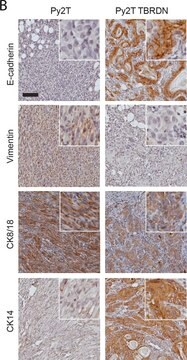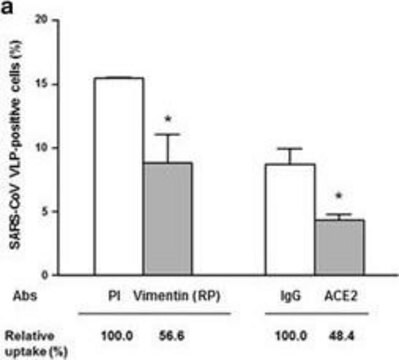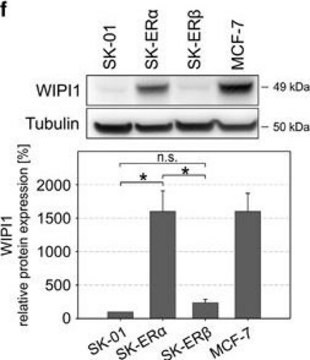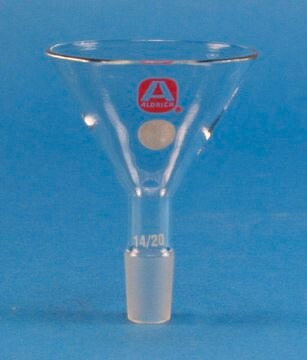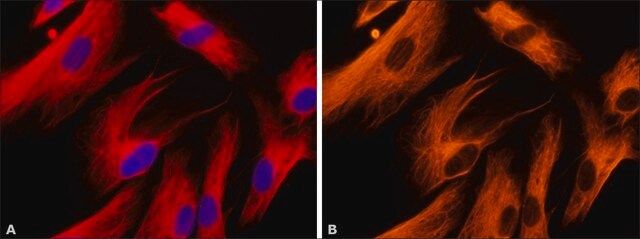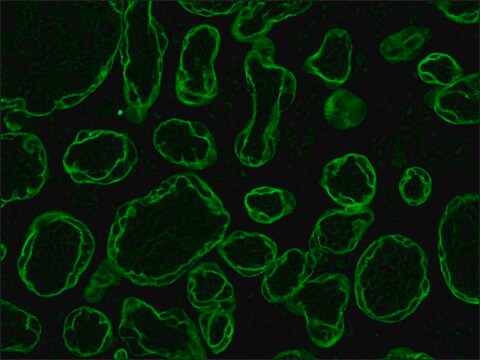W4769
Monoclonal Anti-WIPI-1 antibody produced in mouse
~1.5 mg/mL, clone WIPI1-4, purified immunoglobulin, buffered aqueous solution
동의어(들):
Anti-ATG18, Anti-WIPI-1α, Anti-WIPI49
로그인조직 및 계약 가격 보기
모든 사진(2)
About This Item
UNSPSC 코드:
12352203
결합:
unconjugated
application:
WB
클론:
WIPI1-4, monoclonal
종 반응성:
human, mouse, bovine, rat
citations:
2
기술:
western blot: 2-4 μg/mL using whole extract of G361 cells
추천 제품
생물학적 소스
mouse
결합
unconjugated
항체 형태
purified immunoglobulin
항체 생산 유형
primary antibodies
클론
WIPI1-4, monoclonal
양식
buffered aqueous solution
분자량
antigen ~49 kDa
종 반응성
human, mouse, bovine, rat
농도
~1.5 mg/mL
기술
western blot: 2-4 μg/mL using whole extract of G361 cells
UniProt 수납 번호
배송 상태
dry ice
저장 온도
−20°C
타겟 번역 후 변형
unmodified
유전자 정보
human ... WIPI1(55062)
mouse ... Wipi1(52639)
rat ... Wipi1(303630)
일반 설명
Monoclonal Anti-WIPI-1 (mouse IgG1 isotype) is derived from the hybridoma WIPI1-4 produced by the fusion of mouse myeloma cells and splenocytes from BALB/c mice immunized with a synthetic peptide corresponding to a fragment of human WIPI-1, conjugated to KLH. WIPI-1 (WD repeat domain phosphoinositide-interacting protein 1) the mammalian orthologue of Atg18 in S. cerevisiae and A. thaliana, is a member of the WIPI subfamily of WD-repeat (Trp-Asp) proteins. WIPI-1 has a 7-bladed propeller structure and contains a conserved motif for interaction with phospholipids. WIPI-1 is expressed in normal human tissues with high levels in skeletal muscle, heart and testis.
애플리케이션
Monoclonal Anti-WIPI-1 antibody has been used in immunoblotting, immunoprecipitation.
생화학적/생리학적 작용
WIPI-1 (WD repeat domain phosphoinositide-interacting protein 1) plays an important role in signal transduction, transcription regulation and apoptosis. Endogenous WIPI-1 partially colocalizes with the autophagosomal marker LC3 and induction of autophagy leads to the accumulation of WIPI-1 in large vesicular and cup-shaped structures that are characteristic for autophagy-linked proteins. WIPI-1 is aberrantly expressed in human cancer and is linked to starvation induced autophagy.
물리적 형태
Solution in 0.01 M phosphate buffered saline, pH 7.4, containing 15 mM sodium azide.
면책조항
Unless otherwise stated in our catalog or other company documentation accompanying the product(s), our products are intended for research use only and are not to be used for any other purpose, which includes but is not limited to, unauthorized commercial uses, in vitro diagnostic uses, ex vivo or in vivo therapeutic uses or any type of consumption or application to humans or animals.
적합한 제품을 찾을 수 없으신가요?
당사의 제품 선택기 도구.을(를) 시도해 보세요.
가장 최신 버전 중 하나를 선택하세요:
Noboru Mizushima et al.
Cell structure and function, 27(6), 421-429 (2003-02-11)
Macroautophagy is an intracellular degradation system for the majority of proteins and some organelles. The molecular mechanism of autophagy has been extensively studied using the yeast, Saccharomyces cerevisiae, during these past 10 years. These studies suggested that the molecular machinery
Human WIPI-1 puncta-formation: a novel assay to assess mammalian autophagy
Proikas-Cezanne T, et al.
Febs Letters, 581(18), 3396-3404 (2007)
Tassula Proikas-Cezanne et al.
FEBS letters, 581(18), 3396-3404 (2007-07-10)
Autophagy depends on the activity of phosphoinositide-3 kinase class III to generate PI(3)P. We identified the human WIPI protein family of PI(3)P-binding factors and showed that WIPI-1 (Atg18) is linked to autophagy in human cells. Induction of autophagy by rapamycin
WIPI-1alpha(WIPI49), a member of the novel 7-bladed WIPI protein family, is aberrantly expressed in human cancer and is linked to starvation-induced autophagy
Proikas-Cezanne T, et al.
Oncogene, 23(58), 9314-9314 (2004)
Tassula Proikas-Cezanne et al.
Oncogene, 23(58), 9314-9325 (2004-12-17)
WD-repeat proteins are regulatory beta-propeller platforms that enable the assembly of multiprotein complexes. Here, we report the functional and bioinformatic analysis of human WD-repeat protein Interacting with PhosphoInosides (WIPI)-1alpha (WIPI49/Atg18), a member of a novel WD-repeat protein family with autophagic
자사의 과학자팀은 생명 과학, 재료 과학, 화학 합성, 크로마토그래피, 분석 및 기타 많은 영역을 포함한 모든 과학 분야에 경험이 있습니다..
고객지원팀으로 연락바랍니다.